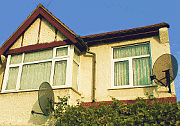|
The south-westernmost part of Streatham, formerly known as Lower or South Streatham, but once a corner of Mitcham. For several
centuries there was little here but fields, the River Graveney and a track connecting Mitcham with Norwood. The route was
often used by gypsies, who had camps in both villages. The Greyhound Inn, established around 1730, became a popular resting
place for these travellers. The opening of Greyhound Lane station in 1862 barely stirred this remote spot and the lane remained
a muddy track for several decades more. In 1875 the station was renamed Streatham Common and half of Greyhound Lane became
Streatham Vale. The first houses appeared on Eardley Road and a handful of industries set up shop, bringing local employment
opportunities. Suburban development abruptly got underway from 1922 as the Streatham Vale estate took shape. Two private building
firms shared most of the work, RH Miller laying out Abercairn Road and its offshoots, while Wates of Norbury built eastwards
from Streatham Vale to the railway line. In the three years from 1929 a profusion of amenities were provided and improvements
made. Schools opened on either side of Streatham Vale; the Greyhound Inn was rebuilt; the Graveney was culverted to prevent
flooding; Streatham Vale Park was laid out on the site of an abandoned brickworks and the new parish church of the Holy Redeemer
was consecrated. Streatham Park cemetery opened in 1920 on Rowan Road, some way from Streatham Park. The comic actor Will Hay was buried here in 1949. The cemetery has a variety artists’ section dedicated to lesser-known performers from the
music hall era. An adjoining Jewish burial ground opened in 1932.
 |

